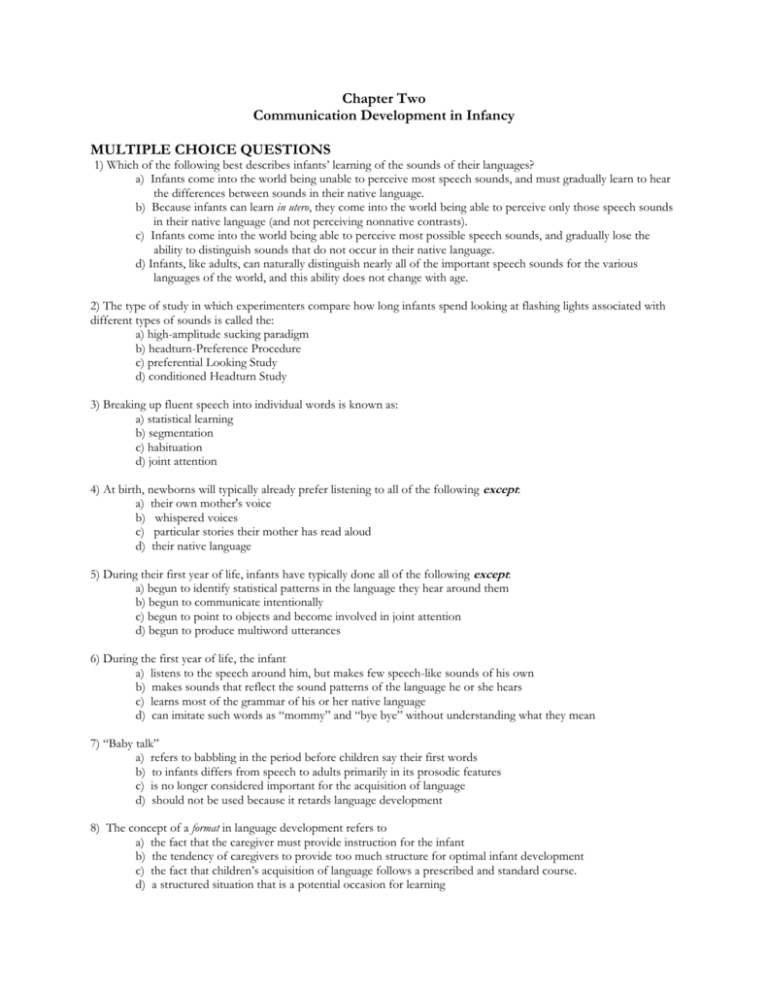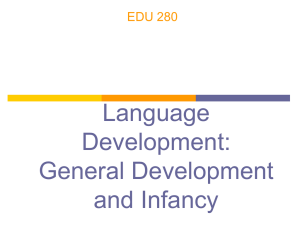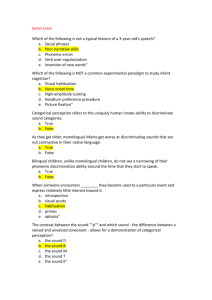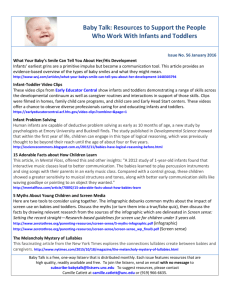Chapter Two Communication Development in Infancy MULTIPLE
advertisement

Chapter Two Communication Development in Infancy MULTIPLE CHOICE QUESTIONS 1) Which of the following best describes infants’ learning of the sounds of their languages? a) Infants come into the world being unable to perceive most speech sounds, and must gradually learn to hear the differences between sounds in their native language. b) Because infants can learn in utero, they come into the world being able to perceive only those speech sounds in their native language (and not perceiving nonnative contrasts). c) Infants come into the world being able to perceive most possible speech sounds, and gradually lose the ability to distinguish sounds that do not occur in their native language. d) Infants, like adults, can naturally distinguish nearly all of the important speech sounds for the various languages of the world, and this ability does not change with age. 2) The type of study in which experimenters compare how long infants spend looking at flashing lights associated with different types of sounds is called the: a) high-amplitude sucking paradigm b) headturn-Preference Procedure c) preferential Looking Study d) conditioned Headturn Study 3) Breaking up fluent speech into individual words is known as: a) statistical learning b) segmentation c) habituation d) joint attention 4) At birth, newborns will typically already prefer listening to all of the following except: a) their own mother's voice b) whispered voices c) particular stories their mother has read aloud d) their native language 5) During their first year of life, infants have typically done all of the following except: a) begun to identify statistical patterns in the language they hear around them b) begun to communicate intentionally c) begun to point to objects and become involved in joint attention d) begun to produce multiword utterances 6) During the first year of life, the infant a) listens to the speech around him, but makes few speech-like sounds of his own b) makes sounds that reflect the sound patterns of the language he or she hears c) learns most of the grammar of his or her native language d) can imitate such words as “mommy” and “bye bye” without understanding what they mean 7) “Baby talk” a) refers to babbling in the period before children say their first words b) to infants differs from speech to adults primarily in its prosodic features c) is no longer considered important for the acquisition of language d) should not be used because it retards language development 8) The concept of a format in language development refers to a) the fact that the caregiver must provide instruction for the infant b) the tendency of caregivers to provide too much structure for optimal infant development c) the fact that children’s acquisition of language follows a prescribed and standard course. d) a structured situation that is a potential occasion for learning 9) In interactions between mothers and their 3-month-old infants, the mothers a) ignored most nonverbal signals from the infants b) grew more and more selective about what vocalizations they considered to be appropriate c) seemed intent on giving the child a turn in the conversation d) expected clearly babbled sounds from the infants 10) Adults probably use baby-talk characteristics to prelinguistic infants because a) the infant pays more attention when they do b) they are attempting to teach the baby how to talk c) baby-talk is necessary for normal infant development d) they are mimicking the baby’s vocalizations 11) Pointing is considered a) an early form of conversational turn-taking b) a typical communicative gesture used by children in the first year of life c) a more sophisticated action, that is generally not understood until the child is well into his second year d) an inadequate substitute for true communicative behavior 12) One criterion for believing that a child is engaging in intentional communication is that a) she no longer uses gestures to accompany her vocalizations b) her mother thinks that she is communicating c) she vocalizes while reaching for objects d) she persists in attempts to communicate if she is not understood 13) All of these are criteria for deciding whether an infant’s behavior is intentionally communicative EXCEPT a) he takes his conversational turn at the appropriate moment b) he persists in attempting to communicate if he is not understood c) he makes eye contact with the partner while gesturing or vocalizing d) he gestures or vocalizes and waits for a response from the partner 14) All of these are common ways researchers assess whether a child is communicating intentionally EXCEPT a) a communicative temptation task b) low structured observation c) a stimulus and response experiment d) all of the above are standard procedures 15) If an adult responds vocally to a 3-month-old’s cooing, the infant will tend to a) begin to cry b) make more speech-like sounds in return c) try to repeat the sounds of the adult’s voice d) make more and louder sounds in return 16) Studies have shown that young children learn vocabulary more quickly if a) they are exposed to educational toys, videos and flashcards b) their caregiver has a verbally sensitive style c) they hear higher quality language in the environment around them d) their caregiver spends the time and energy to direct the child’s attention to interesting objects, providing appropriate labels for them all the time 17) If an infant utters the sound “tata!” every time he sees the cat, this expression is considered a) a preword b) a metaword c) a protoword d) an anteword 18) The use of ‘baby signing’ as a means of communicating with babies before they can talk a) b) c) d) has been shown to delay the onset of normal speech has been shown to accelerate the onset of normal speech has been shown to boost scores on later cognitive assessments has not been studied enough to make recommendations about whether parents should or should not use signs 19) In a study of intentional communication, an experimenter shows a child an attractive toy and then puts it on a high shelf, out of the child’s reach. This is an example of a) low structured observation b) a MacArthur Communicative Development test c) a communicative temptation task d) an object permanence assessment 20) All of these are associated with the emergence of intentional communication EXCEPT a) the maturation of the central nervous system b) the nonlinguistic cognitive development of the child c) the types of experience the child has had with his caregivers d) the use of intelligence boosting toys and mobiles 21) The feature of baby talk that infants seem to prefer over all others is a) higher pitch b) sing-song prosody c) positive affect d) rhyming 22) When a mother points at a dog and says “Look! A doggie!” to her seven month old, she is a) establishing joint attention b) familiarizing the child with his environment c) explicitly teaching the child vocabulary words d) probably not affecting the child’s language development one way or the other 23) During the first year of life, infants a) cannot discriminate fine distinctions among the sounds of the language spoken around them b) lose the ability to discriminate fine distinctions among sounds of languages not spoken around them c) are able to produce all the sounds of every known human language d) can learn the sounds of a language not spoken around them if they are exposed to that language via television or radio broadcasts 24) A feature of child directed speech in English that is likely to have an important effect on a child’s language comprehension is a) the use of the “ie” suffix added to many words b) exaggerated stress and intonation patterns c) rapid speech and changing of subjects d) lower pitch and repetition of important words 25) Children of depressed mothers have been shown to a) learn words at essentially the same rate as children of normal mothers b) have poorer associative learning of words than children of normal mothers c) speak with flatter pitch than children of normal mothers d) have language delays that can have life-long effects TRUE/FALSE QUESTIONS 1) At birth, infants already prefer their mothers’ voices over those of strangers. 2) Young infants tend to prefer speech that has baby talk intonation patterns. 3) Adults who are not familiar with child development typically do not interpret an infant’s behavior as communicative until the infant has begun to talk. 4) Baby talk has virtually identical characteristics in every culture that has been studied. 5) From about two months of age onwards, infants are able to behave deliberately in order to obtain adult attention and assistance. 6) A child exposed to a large quantity of adult-to-adult speech will learn language at about the same rate as a child who is exposed to a large quantity of direct adult-to-child speech. 7) Infants can hear the sound of their mother’s voices in utero. 8) Most children begin to understand their first words at about twelve months. 9) When a mother treats her three month old as a full-fledged conversational partner, this is known as a linguistic format. 10) If a ten-month old says “zoo-zoo” every time she sees a car go by, “zoo-zoo” may be a protoword. SHORT ANSWER QUESTIONS 1) When do developing individuals first begin to hear sounds and how does this affect language development? 2) What is a protoword? Give an example. 3) List three common characteristics of baby talk in English to preverbal infants. Are these characteristics universal? 4) What is meant by the term joint attention? Give an example. 5) Is pointing an important communicative behavior? Does it have implications for the development of language? Why or why not? 6) Give an example of a structured situation or format that might help a child learn language. 7) A preverbal infant wants a toy that is nearby, but out of reach. Describe two kinds of intentional communicative acts she might employ. 8) Do infants actually prefer to hear baby talk intonation? Describe an experimental design to test this. ESSAY QUESTIONS 1) Distinguish between communication and intentional communication in the first year of life. What criteria may be used to identify intentional communication? 2) Define and give examples of three communicative functions that emerge in the first year of life. 3) One important question is whether differences in the interactional style of caregivers affect their infants’ communicative development. Suggest some sources of evidence that have addressed or can address this issue. 4) The infant is not a passive recipient of adult speech. Describe ways in which the infant influences the language and behavior of the caregiver. How might this interaction affect the development of language? 5) Researchers have claimed that parents “impute intentionality to pre-intentional babies.” Explain this statement, and provide an example. What effects might this have on the development of language? Chapter Two Communication Development in Infancy MULTIPLE CHOICE QUESTIONS 1. Answer c. Page 31 2. Answer b. Page 32 3. Answer b. Page 32 4. Answer b. Page 30 5. Answer d. Page 33-38 6. Answer: b. Page 34 7. Answer: b. Page 39 8. Answer: d. See page 44 9. Answer: c. Page 40-41 10. Answer: a. Pages 39 11. Answer: b. Page 36 12. Answer: d. Page 35 13. Answer: a. Page 35 14. Answer: c. Page 37-38 15. Answer: b. Page 34 16. Answer: b. See page 43 17. Answer: c. Page 37 18. Answer: d. Page 37 19. Answer: c. Page 37 20. Answer: d. See page 44 21. Answer c. Page 39 22. Answer a. Page 43 23. Answer: b. Page 32 24. Answer: b. Page 39 25. Answer: b. Page 40 TRUE/FALSE QUESTIONS 1. TRUE 2. TRUE 3. FALSE 4. FALSE 5. FALSE 6. FALSE 7. TRUE 8. FALSE 9. FALSE 10. TRUE







